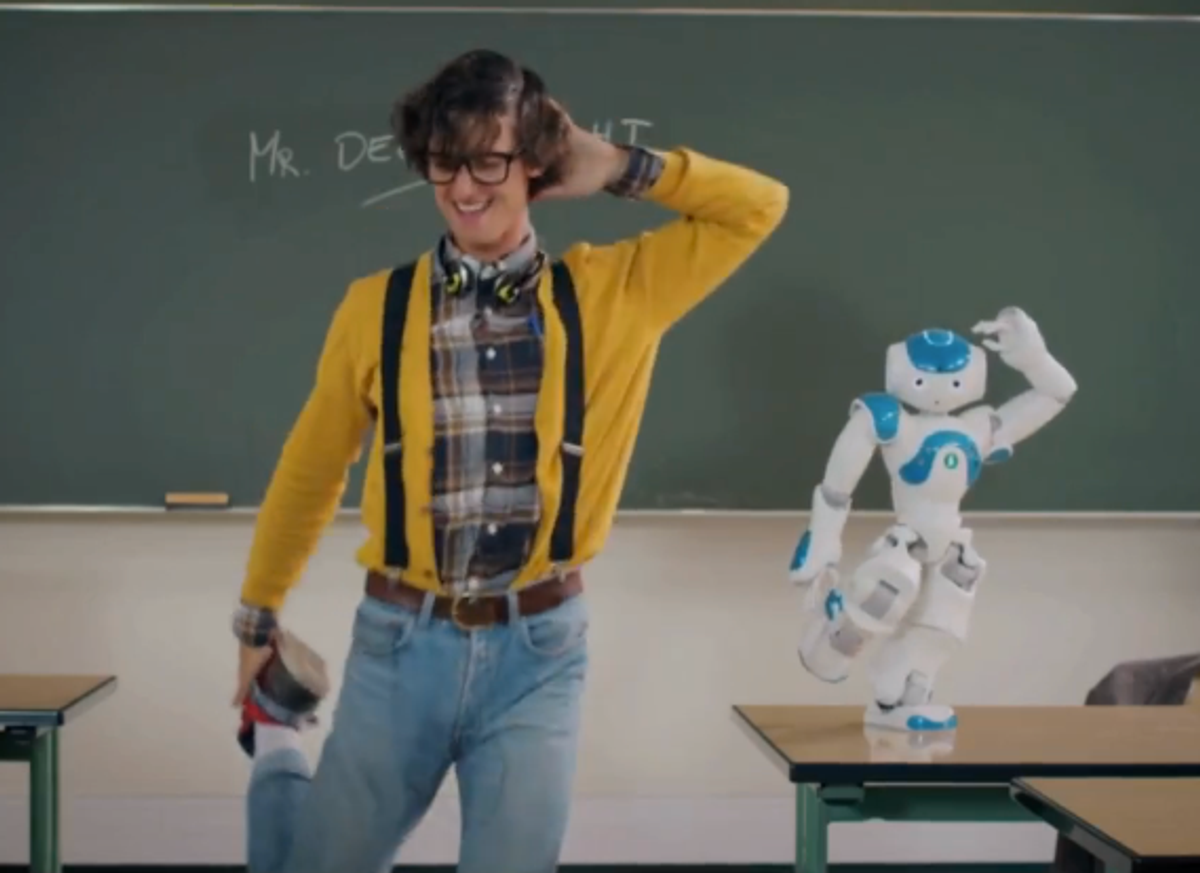In this edition of Video Friday, Nao goes to school, snake robot goes on vacation, and strange robot sightings are reported in San Francisco.
Last week, we got a strange email describing several robot sightings in San Francisco. YouTube videos showed KITT, the Knight Rider car, escaping from a garage, a group of Naos riding the subway, and a Mars rover taking a stroll on the Golden Gate promenade. Hmmm ... We immediately suspected it was all a viral marketing stunt. And by someone with deep pockets to stage these elaborate performances. And we were right! It's a marketing campaign by GE called "Brilliant Machines." It features some really famous robots, including Data from Star Trek, B9 from Lost in Space, and Robby the Robot from Forbidden Planet. Apparently GE has new products that will incorporate some AI capabilities and the company thought that using robots would help drive the point. Well, it got our attention, though we were hoping for a cool new robot movie (Robopocalypse was our guess), not a TV commercial. Check out the video below and this Tumblr page for more "robot sightings."
Shigeo Hirose from the Tokyo Institute of Technology is famous for his bio-inspired robotic snakes, and among his most impressive creations is the ACM-R5 snake bot. In this new video, we see the latest version, called ACM-R5H, developed in collaboration with Tokyo Tech spin-off HiBot. We have no idea why the video is called "HiBot ACM-R5 in Hollywood" (is the snake pursuing a movie career?), but who cares? It's just the coolest thing to watch this machine having some fun in the water.
[ HiBot ]
I love robots that balance on balls. There's something fascinating about robots that have no legs, no wheels, no tracks. They're on a perpetual balancing act. But granted, other than research or artistic purposes, why build a ball-balancing robot? What application could possibly require such a machine? Now University of Idaho engineers have an answer to that question. And the answer is: a marching band drum, of course! With a conventional drumset, the drummer has to use a harness to carry the instrument around. You can guess it's probably not easy nor comfortable. So the engineers created the Human-Assisted Robotic Drumset. It consists of a ball-balancing mechanism that supports the weight of the drumset and senses the movements of the drummer, helping to move the instrument in the desired direction.
Automaton readers might remember the superfast Japanese book scanner we wrote about a couple of years ago. Created by University of Tokyo researchers, the machine users a 1000-frame-per-second camera system—the same system that allows robot hands to catch eggs in mid-air among other high-speed feats—to photograph a book as its pages flip. Special software detects the curvature of the scanned pages and flattens the images. With the device you could in theory scan an entire book in seconds! But flipping a book manually has its problems: you might skip pages or the quality of the scans might not be good enough. So now the researchers have engineered a device that can hold the book and flip through the pages carefully. They say the scanner can achieve 250 pages per minute.
[ Ishikawa Oku Laboratory ] via [ Dvice ]
Early this year, we saw a squad of flying robots playing the James Bond theme. Now researchers at Georgia Robotics and Intelligent Systems (GRITS) Lab at Georgia Tech have programmed a swarm of tiny mobile robots to perform Beethoven's Fur Elise on a simulated piano. Why would you want to teach a bunch of mini bots to play the piano? The researchers explain: "By solving the corresponding spatio-temporal routing problem, the smallest possible robot team is deployed in order to effectively 'play' the musical score, while minimizing the total distance travelled."
Automaton readers are also familiar with the Cyclocopter developed at the University of Maryland by Moble Benedict, Matthew Westerfield, Vikram Hrishikeshavan, and Prof. Inderjit Chopra. Instead of conventional helicopter blades, this flying robot uses cycloidal-rotors (cyclorotors). Its creators claim the mechanism has advantages such as higher aerodynamic efficiency and maneuverability and the ability to take-off and land vertically. The current model has a twin-cyclorotor and a horizontal tail rotor configuration, and in ther latest video the researchers demonstrate stable autonomous hover using a novel attitude control technique using differential RPM control of the rotors and thrust vectoring for rolling and yawing.
Thanks, Moble!
Nao is by far one of the coolest robots around. It can dance better than most of us, play soccer, tell stories, and perform comedy routines. It's used in research by robotics labs all over the world, and also by researchers and doctors to help kids in hospitals. But there's one place that we think Nao would have an even greater impact: schools. Several universities already use Nao in classrooms to teach robotics, AI, and computer science. The little humanoid, however, could play an important role in high school education (secondary school, as it's known in some countries). Nao could be used to make some math and physics concept more interesting to study. Some schools are already experimenting with this idea, but it would be great to see this happen on a larger scale. Imagine students equipped with tablets, prototyping electronic boards like the Arduino, 3D printers, and also robots in their classrooms! Almost makes me wish I could go back to school. Almost.
Erico Guizzo is the Director of Digital Innovation at IEEE Spectrum, and cofounder of the IEEE Robots Guide, an award-winning interactive site about robotics. He oversees the operation, integration, and new feature development for all digital properties and platforms, including the Spectrum website, newsletters, CMS, editorial workflow systems, and analytics and AI tools. An IEEE Member, he is an electrical engineer by training and has a master’s degree in science writing from MIT.




